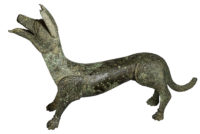 The glaring loophole in the 1996 Treasure Act strikes again, this time the victim is the unique Roman bronze statue of a dog with his tongue out discovered by metal detectorists in Gloucestershire in August 2017.
The glaring loophole in the 1996 Treasure Act strikes again, this time the victim is the unique Roman bronze statue of a dog with his tongue out discovered by metal detectorists in Gloucestershire in August 2017.
The dog is 5 ¼ inches high and 8 ½ inches long and is posed with his head looking upwards, his mouth open and his tongue poking out. Both the front shoulders are engraved with a stylized leaf or feather motif. Fur details are engraved on his jowls, paws, genitals and hind haunches as well. Holes found under his paws and a square hole in its belly indicate he was mounted to a base originally. It dates to the 4th century A.D.
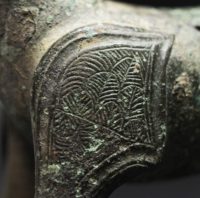 The licking dog is believed to represent healing as the Greek god of medicine, Asclepius, had a canine companion. Dogs were believed to be able to heal injuries with their lick. An Iron Age temple to the local Celtic healing god Nodens, who was also a hunting deity and was associated with dogs in that capacity as well, was discovered at Lydney Park, Gloucestershire, not far from where the hoard was found. Seven votive dogs have been unearthed at Lydney and at some at Llys Awel in Wales as well, but none of them are comparable in size, quality of material, construction and decoration to this one. It is unique in the British archaeological record.
The licking dog is believed to represent healing as the Greek god of medicine, Asclepius, had a canine companion. Dogs were believed to be able to heal injuries with their lick. An Iron Age temple to the local Celtic healing god Nodens, who was also a hunting deity and was associated with dogs in that capacity as well, was discovered at Lydney Park, Gloucestershire, not far from where the hoard was found. Seven votive dogs have been unearthed at Lydney and at some at Llys Awel in Wales as well, but none of them are comparable in size, quality of material, construction and decoration to this one. It is unique in the British archaeological record.
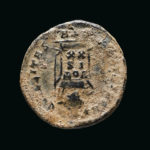
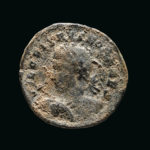 The rest of the hoard consists of a group of fragments, one bearing a partial inscription, furniture fittings, vessel handles, wires, mounts and fragments of what was once a figurine of a man wearing an intricately draped garment. There is one coin in the hoard, a follis of Crispus, the son of Constantine the Great, with globe-on-altar reverse. This type of coin was minted at Trier between 321-324 A.D., which means the earliest date the hoard could have been buried was 321. Archaeologists think the large number of scraps in the hoard indicate it was buried by a metalworker who intended to melt them down and never got the chance.
The rest of the hoard consists of a group of fragments, one bearing a partial inscription, furniture fittings, vessel handles, wires, mounts and fragments of what was once a figurine of a man wearing an intricately draped garment. There is one coin in the hoard, a follis of Crispus, the son of Constantine the Great, with globe-on-altar reverse. This type of coin was minted at Trier between 321-324 A.D., which means the earliest date the hoard could have been buried was 321. Archaeologists think the large number of scraps in the hoard indicate it was buried by a metalworker who intended to melt them down and never got the chance.
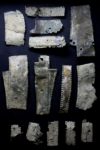 When the discovery was announced in September 2017, the hoard was at the Bristol Museum & Art Gallery where experts were studying it. After that, it was slated to go the British Museum for assessment by the Valuation Committee. Since then, I can find no reports of a coroner’s inquest to determine its treasure status, and the record in the Portable Antiquities Scheme database obviously needs updating because the hoard is categorized as “Undergoing further examination at a museum.”
When the discovery was announced in September 2017, the hoard was at the Bristol Museum & Art Gallery where experts were studying it. After that, it was slated to go the British Museum for assessment by the Valuation Committee. Since then, I can find no reports of a coroner’s inquest to determine its treasure status, and the record in the Portable Antiquities Scheme database obviously needs updating because the hoard is categorized as “Undergoing further examination at a museum.”
As there is only one coin in the group and everything from furniture fittings to plaque fragments to the dog statue is made of a bronze (so not a precious metal), this unique object of British cultural heritage does not qualify as treasure under the Act. The proposed revision of the act would classify any Roman artifact of any estimated value no matter what its composition as treasure. In fact, the coin alone would qualify the hoard as treasure under the revisions, as single coins between 43 A.D. and 1344 satisfy the criteria.
The entire hoard is going under the hammer at Christie’s Antiquities sale on July 3rd. It is being offered as a single lot with a pre-sale estimate of $37,620-62,700. I can but hope that the price doesn’t skyrocket like it did with the Allectus aureus and that a local museum wins the bidding.